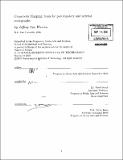| dc.contributor.advisor | David Small. | en_US |
| dc.contributor.author | Warren, Jeffrey Yoo | en_US |
| dc.contributor.other | Massachusetts Institute of Technology. Dept. of Architecture. Program in Media Arts and Sciences. | en_US |
| dc.date.accessioned | 2011-08-18T19:18:05Z | |
| dc.date.available | 2011-08-18T19:18:05Z | |
| dc.date.copyright | 2010 | en_US |
| dc.date.issued | 2010 | en_US |
| dc.identifier.uri | http://hdl.handle.net/1721.1/65319 | |
| dc.description | Thesis (S.M.)--Massachusetts Institute of Technology, School of Architecture and Planning, Program in Media Arts and Sciences, 2010. | en_US |
| dc.description | Cataloged from PDF version of thesis. | en_US |
| dc.description | Includes bibliographical references (p. 109-113). | en_US |
| dc.description.abstract | Geospatial tools and information play an important role in urban planning and policymaking, and maps have diverse uses in legal, environmental, political, land rights, and social arenas. Widespread participation in mapmaking and access to its benefits is limited by obscure and expensive tools and techniques. This has resulted in poor or nonexistent maps for much of the world's population, especially in areas of urban poverty. In particular, public access to recent and high-resolution satellite imagery is largely controlled by government and large industry. This thesis proposes balloon and kite aerial photography as a low-cost and easy to learn means to collect aerial imagery for mapping, and introduces a novel open-source online tool for orthorectifying and compositing images into maps. A series of case studies where such tools and techniques were used by communities and activists in Lima, Peru and during the 2010 BP oil spill highlight the empowering role broader participation in cartography can play in advocacy, and the potential for increased cartographic literacy to level the playing field in territorial self-determination for small communities. Compared to other efforts to democratize mapmaking, which focus primarily on the presentation and interpretation of existing map data, this project emphasizes participation in the creation of new data at its source - direct imaging of the earth's surface. Accompanying educational materials and workshops with adults and youth, as well as an active online community of participants, have ensured wide adoption of Grassroots Mapping practices. | en_US |
| dc.description.statementofresponsibility | by Jeffrey Yoo Warren. | en_US |
| dc.format.extent | 115 p. | en_US |
| dc.language.iso | eng | en_US |
| dc.publisher | Massachusetts Institute of Technology | en_US |
| dc.relation.requires | Two DVD-ROMs contain supplemental material for thesis. | en_US |
| dc.rights | M.I.T. theses are protected by
copyright. They may be viewed from this source for any purpose, but
reproduction or distribution in any format is prohibited without written
permission. See provided URL for inquiries about permission. | en_US |
| dc.rights.uri | http://dspace.mit.edu/handle/1721.1/7582 | en_US |
| dc.subject | Architecture. Program in Media Arts and Sciences. | en_US |
| dc.title | Grassroots mapping : tools for participatory and activist cartography | en_US |
| dc.title.alternative | Tools for participatory and activist cartography | en_US |
| dc.type | Thesis | en_US |
| dc.description.degree | S.M. | en_US |
| dc.contributor.department | Program in Media Arts and Sciences (Massachusetts Institute of Technology) | |
| dc.identifier.oclc | 745810511 | en_US |
